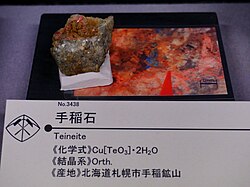Chemistry:Teineite
| Teineite | |
|---|---|
 | |
| General | |
| Category | Mineral |
| Formula (repeating unit) | Cu(TeO3)·2 H2O |
| Strunz classification | 4.JM.20 |
| Dana classification | 34.2.2.2 |
| Crystal system | Orthorhombic |
| Crystal class | Disphenoidal (222) H-M symbol: (2 2 2) |
| Space group | P212121 |
| Unit cell | a = 6.63, b = 9.61 c = 7.43 [Å]; Z = 4 |
| Identification | |
| Color | Sky-blue, cobalt-blue, bluish gray, bright blue to greenish blue in transmitted light. |
| Crystal habit | Prismatic or flattened crystals, Sometimes as crusts or aggregates |
| Cleavage | Distinct |
| Fracture | Brittle |
| Tenacity | Brittle |
| Mohs scale hardness | 2.5 |
| |re|er}} | Vitreous, dull |
| Streak | Light blue |
| Diaphaneity | Semitransparent |
| Specific gravity | 3.8 |
| Optical properties | Biaxial (−) |
| Birefringence | δ = 0.024 |
| Pleochroism | Various shades of blue |
| 2V angle | 36o |
| Fusibility | Fusible, gives a black bead |
| Solubility | Insoluble |
| Common impurities | Sulfur |
| References | [1][2][3][4] |
Teineite is a tellurite mineral with the formula Cu(TeO3). 2 H2O. It has a Mohs hardness of 2.5 and it comes in many different shades of blue, ranging from cerulean blue to bluish-gray. The mineral millsite has the same chemical composition, but crystallizes in the monoclinic system, while teineite crystallizes in the orthorhombic system.[2][3][4]
Occurrence
Teineite was first identified in the Teine mine, Sapporo, Hokkaido, Japan , where the name of this mineral originates. It occurs in veins where copper- and tellurium-bearing sulfides were oxidized and is often associated with tellurite, tellurium, pyrite, tetrahedrite, sphalerite, azurite, malachite, quartz, baryte, hessite, galena, bornite, cerussite, chlorargyrite, quetzalcoatlite, cuprite and graemite.[5][6] It has also been found in other places, including other mines in Japan, several mines in the United States and mines in Mexico, Belgium, Russia and Norway .[2][5]
See also
References
- ↑ Warr, L.N. (2021). "IMA–CNMNC approved mineral symbols". Mineralogical Magazine 85 (3): 291–320. doi:10.1180/mgm.2021.43. Bibcode: 2021MinM...85..291W.
- ↑ 2.0 2.1 "Teineite: Teineite mineral information and data.". http://www.mindat.org/min-3902.html.
- ↑ "Millsite: Millsite mineral information and data.". http://www.mindat.org/min-46965.html.
- ↑ Barthelmy, Dave. "Teineite Mineral Data". http://www.webmineral.com/data/Teineite.shtml#.V9_6oSh9600.
- ↑ 5.0 5.1 "Handbook of mineralogy". http://www.handbookofmineralogy.org/pdfs/teineite.pdf.
- ↑ Yosimura, Toyohumi (1936). "Teineite, a New Tellurate Mineral from the Teine Mine, Hokkaidō, Japan". Journal of the Faculty of Science, Hokkaido Imperial University 4. http://eprints.lib.hokudai.ac.jp/dspace/bitstream/2115/35801/1/4(3-4)_465-470.pdf. Retrieved 2016-09-19.
 |

